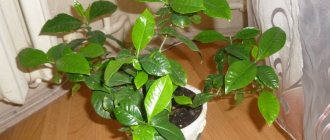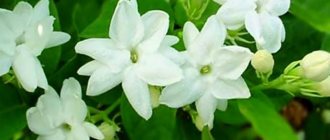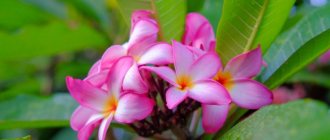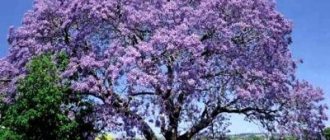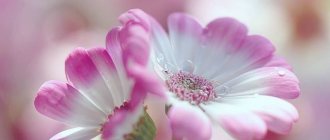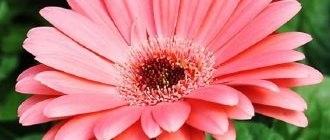Jasmine grows quickly: a rooted cutting planted in the ground can reach the height of an adult plant - 2 meters in almost a year. Jasmine often grows by wrapping its strong stem around a support. The time and duration of flowering, the color and shape of flowers depend on the type of plant. What they have in common is an elegant appearance and a unique sweetish aroma.
| Growing quickly. |
| Jasmine blooms from January to March. |
| The plant requires special conditions. |
| Perennial. |
Useful properties of jasmine
Only multi-flowered (medicinal) jasmine with simple white flowers is endowed with healing properties. Every part of the plant contains useful substances. Based on them, drugs are produced to strengthen the nervous system, normalize blood pressure, and treat the liver. Jasmine in the form of infusions, decoctions, and tea has analgesic, antiallergic, sedative and antiseptic effects. Restores hormonal balance in the body.
Green tea with jasmine relieves nervous tension, increases performance, and improves mood. Jasmine leaves are used to reduce body temperature. A decoction of flowers increases lactation, and a decoction of leaves stops it. Hot compresses are used for skin ulcers.
Jasmine essential oil, used in perfumery, is very expensive all over the world, because about 7 million flowers are consumed to produce 1 liter of oil. The smell of jasmine improves mental activity, invigorates and creates an atmosphere of harmony. Inhalations with oil are carried out for laryngitis.
climbing vine
The variety that came from the tropics has about 300 species and each of them is beautiful and unique in its own way; photos of jasmine are literally mesmerizing. The evergreen plant is used for landscaping greenhouses and creating entire landscapes thanks to its climbing features.
An adult can reach from 1 to 10 meters in height; such impressive dimensions are not always suitable for small spaces. The branches are quite flexible and clinging, this allows you to easily decorate the spectacular structure at your personal discretion.
Caring for jasmine at home (briefly)
When jasmine at home receives sufficient nutrition, water, light and warmth, it develops harmoniously and responds to care with a healthy appearance and lush flowering. To make the flower feel comfortable, conditions suitable for it are created in the room:
| Temperature | In winter – up to + 13°C (at higher temperatures the flowers may not open); the minimum temperature that jasmine can withstand is + 8°C; spring – autumn – + 15 – 23°C; must be protected from drafts and sudden changes in temperature. |
| Air humidity | Increased; regularly spray the leaves without getting on the flowers; It is useful to keep the pot on a tray with moistened expanded clay. |
| Lighting | Bright diffused light is needed; window facing southeast or southwest; on the window on the south side the bush is shaded at noon, on the north side - lighting is installed. |
| Watering | During growth in summer - after 2 days, so that the soil remains moist; In autumn, watering is reduced; in winter - once every 7 days, the soil should dry out in between waterings. |
| Priming | Good drainage is needed; You can independently prepare a soil mixture from equal doses of leaf soil, perlite or sand, humus and a double dose of turf soil. |
| Feeding and fertilizer | Liquid diluted fertilizers during the growing season 2 times every 30 days; in autumn - once a month; In winter, feeding is stopped. |
| Transfer | Young bushes - every year after flowering, adults - once every 2.5 years; They bloom better in cramped containers. |
| Reproduction | Apical cuttings with several buds. |
When performing all the traditional flower care procedures, you need to know that there are specifics to growing jasmine. After flowering, the regrown shoots are cut by 2/3. The bush needs to be ventilated periodically. Jasmine is grown using support.
Primary requirements
The first thing you need to start with is preparing the soil for filling the pot; the pH meter readings will be around 6 for a good result. Mixing the composition is also taken quite seriously; the soil mixture must be loose and nutritious to achieve maximum results.
Ready-made mixtures are sold on the market, but if the mixing process is done independently, then you need to maintain the ideal proportion of the following components:
- Sand.
- Peat.
- Deciduous soil.
- Clay-woody.
Each flower is planted in separate containers for convenience, the diameter of which should be at least 5 centimeters. Over time, the root system will develop and require more space; the optimal size is considered to be 9-11 centimeters in diameter for pots.
Caring for jasmine at home. Details
Growing homemade jasmine is not an easy task. A beautifully flowering plant is sensitive to any change in usual conditions. The environment in which the bush will grow must be stable. The florist must carefully note all the nuances of the plant’s contents and quickly respond to their changes, only then the jasmine will bloom perfectly.
Jasmine blossom
The beautiful long-lasting flowering of the plant is the result of careful care for it. Jasmine blossoming is a phenomenon that enchants with the beauty of its flowers and unique aroma. Dark green, perfectly oval leaves with pointed tips set off the flowers, which are single or collected in racemes. The color palette of flowers is varied. Although snow-white and cream shades are traditionally considered classic, jasmine petals can be colored in different tones of pink and yellow.
The shape of simple or double flowers is also varied. Most often they resemble stars. There are types of jasmine with flowers similar to peony or rose. Flowering occurs in different species at different times. Typically, indoor species bloom within 3 weeks if the jasmine has rested well in a cool room before that. There are types of jasmine that do not have flowers.
Temperature
Maintaining a certain temperature regime is important for the plant to develop properly. Jasmine at home will bloom wildly if it spends the winter in a cool place. At temperatures above + 13°C, its flowers may not open.
To maintain the temperature at this level, the room is often ventilated. The rest of the time, jasmine will feel comfortable at + 15 - 23°C. In summer, the plant is taken out into the garden or onto the balcony.
It is important to avoid sudden changes in temperature and protect the flower from drafts.
Spraying jasmine
In a room with dry air, jasmine convulsively squeezes its beautiful glossy leaves. Low humidity causes plant diseases, disrupts flowering, and provokes pest invasion. A good way to increase the level of air humidity is to spray the leaves with settled lukewarm water.
You need to spray carefully, trying not to get water on the flowers. The procedure is carried out throughout the year, excluding winter. After spraying, jasmine is protected from bright sun to avoid burning the leaves. To enhance the effect, the flower is placed in a tray with moistened expanded clay.
Lighting
Sufficient lighting is the key to the development of a healthy and beautiful plant. A jasmine flower at home needs bright, diffused light.
Due to lack of light, the bush will stop growing, lose its decorative effect, stretch out and will not bloom. When there is too much bright light, the plant can get leaf burn. If the lighting level increases, jasmine is gradually accustomed to it. It is best to place the flower on windows facing southeast or southwest. In the southern part of the house the bush is shaded at noon, and in the northern part additional lighting is installed.
In winter, a flower on vacation does not need lighting, and blooming jasmine grows at this time under fluorescent or phytolamps.
Watering jasmine
For jasmine to bloom beautifully, home care requires proper watering. In summer it is important that the soil remains moist, so water every 2 days. In autumn, water less often. In winter, make sure that the soil dries out a little between waterings; to do this, water it a maximum of 2 times every 7 days.
If jasmine blooms in winter, water it once every 5 days. After flowering, watering is reduced. They try not to over-moisten the bush, so as not to cause death due to rotting of the roots. The soil should be moist, but not wet. For irrigation, use soft, lukewarm water. Jasmine responds well to settled rainwater. Twice every 30 days, the water is acidified with citric acid (3 - 5 crystals or a few drops of lemon juice per 1 liter of water). This will improve flowering and keep the flower in good shape. After watering, the soil is mulched with coconut substrate or sphagnum.
Jasmine pot
It is important to choose the right pot for jasmine, then it can fully develop. The diameter of the new container should exceed the diameter of the previous one by no more than 3 cm. The height of the pot also increases. In this case, the roots of the plant will be conveniently located, and the optimal amount of soil can be poured into the container.
Jasmine develops well in cramped conditions, and a large amount of “extra” soil in the pot will cause it to sour and become heavier. Under these conditions, the plant will “fatten”, growing leaves and root systems to the detriment of flowering.
There should be a hole at the bottom of the pot for drainage.
Soil for jasmine
The soil for jasmine needs to be well-drained and loose. Jasmine prefers soil with a neutral acidity level (pH approximately 6 - 7). A universal substrate for houseplants is well suited, to which you can add a little coniferous soil.
You can make the soil mixture yourself from leaf soil, peat, greenhouse soil, humus, taken in equal parts, with the addition of ½ part sand.
Feeding and fertilizer
Feeding and fertilizer are very important for jasmine during growth and flowering. Once every 10 days, use liquid mineral fertilizer for indoor plants, diluted 2 times. Once every 30 days, apply diluted organic fertilizers.
After flowering ends, feeding is suspended until the next flowering.
All fertilizers are applied after watering, preferably in the evening.
Jasmine transplant
Replanting jasmine is a natural process necessary for the flower to develop optimally. Young bushes need to be replanted annually, adults - less often, once every 3 years. Having chosen a pot of the appropriate size and prepared the soil, the jasmine is carefully replanted (transferred).
We must try not to damage the roots. If possible, do not destroy the lump of old soil, sprinkling it with new soil. Be sure to pour a thick layer of broken brick or expanded clay onto the bottom of the pot for drainage. The transplanted jasmine is watered, mulched and left in a shaded place for several days. The procedure is carried out after flowering and cutting the jasmine.
Trimming
Pruning is needed to rejuvenate and form the crown of the bush. Jasmine loves a haircut, which is carried out annually before the start of the growing season. Species that bloom in winter are pruned in the fall, when the intensive growth phase begins. There are fast-growing types of jasmine. They are pruned twice: after a period of active growth and before flowering begins.
Using clean, sharp scissors or pruning shears, carefully cut the side shoots in half. This will cause lush flowering and stop the growth of shoots. Weak, skinny branches, as well as branches with deformed small leaves, are removed completely. When a young bush has 7–8 pairs of leaves, pinch the tops of the shoots to encourage branching.
A similar sign
The signs about whether it is possible to keep Stephanotis at home are so diametrically opposed that they are practically divided into two camps. This capricious plant, increasingly found in indoor floriculture, quickly acquired a mass of myths, superstitions and legends, sometimes of a contradictory nature.
What is the sign if the gardenia home flower is blooming?
Gardenia reflects family relationships. If people in the house often quarrel and find fault with each other, then the flower will look untidy. This happens because the plant is nourished by the home atmosphere. Thus, if it literally blooms and smells, the foliage has a lush green color, and the flowering is abundant, then the home is in order, as are the relationships between family members.
The first time of a flower’s life in the house is separately noted. They say that its rapid flowering, at least in the first year of residence among new hosts, marks financial gain. It is not known exactly where the money will come from. Maybe someone in the family will find a good job or get a decent promotion.
Attention! It happens that with proper care the plant fades.
However, this is considered a sign and has separate explanations. A yellowing Gardenia means that problems are coming, and within the family, since the indoor flower is fueled by energy, including negative energy. Fading flowers and foliage must be torn off immediately so that the negative does not stagnate and does not return back to the household.
It is noted that Gardenia promotes accelerated healing of sick people. Thus, it is recommended to plant it where an elderly person lives who is experiencing various types of ailments. Gardenia promises to help the patient, replacing his pain with improved well-being.
The plant will be a wonderful decoration for any interior.
Popular beliefs
For women
For men
Impatiens are considered to be a male flower, so there are plenty of signs associated with the stronger sex.
It is especially useful to keep Vanka wet in a house where there are elderly people. The flower protects their health, charges them with positive emotions and vigor.
A sick flower, even if it is carefully cared for, predicts the onset of difficult times for the owners. If the plant was cured, difficulties will be avoided; if it died, many tears will have to be shed.
Please note: if you are visited by a person and after he leaves the plant withers or loses its leaves, the visitor experiences negativity towards your family.
If you were given a balsam, but it does not bloom for a long time, the person who gave the gift was planning evil against someone in your family.
Why does a houseplant bloom?
A healthy plant that pleases its owners with beautiful blooms promises them a stable and prosperous course of life.
Jasmine propagation
Jasmine is propagated vegetatively - by cuttings and layering.
Propagation of jasmine by cuttings
Propagation by cuttings is a popular way to obtain a new jasmine bush.
- In spring, cuttings are cut from mature stems, in summer - from young shoots. They do this when the bush does not bloom.
- Cuttings up to 15 cm long, with at least 3 internodes, are cut with a sharp knife along the oblique.
- They are kept in a solution of a root growth stimulator for several hours, dried and dusted with charcoal.
- Place in a damp peat-sand mixture, deepening it to 2.5 cm.
- Cover with polyethylene, making holes in it for ventilation.
- Leave at + 20°C, periodically ventilating and watering. After about 30 days, roots appear.
- The seedlings are placed in separate small pots. You can root in water by adding a little crushed coal to it.
Reproduction of jasmine by layering
Reproduction by layering is easy and painless for the plant. If there is enough space in the pot where jasmine grows, dig in a shoot of the plant, scraping off the bark and treating this place with a root growth stimulator. If there is not enough space in the pot, another container filled with soil is placed next to it, and the cuttings are buried in it. When rooting occurs, the cuttings are cut from the mother plant and replanted.
Both propagation options are simple. When they are used, all varietal characteristics of the mother plant are preserved.
Planting in open ground
We select a place. The shrub does not like too shaded places and excess moisture in the soil. In a garden plot, you can plant it on the east or west side, next to other crops and buildings. Planting begins in March.
Soil composition for planting:
- 3 parts – sheet filling;
- 1 part – clay-turf;
- 1 part – sand.
If you are replanting an old plant, you can take two parts of the clay-turf mixture. Do not use saline or waterlogged soil for planting. A hole 60x60x60 is dug and shrubs are planted in it. The dimensions depend on the size of the root system. It is advisable to take care of the drainage base - 15 cm from the bottom of the hole. For drainage, use small chips, stones, expanded clay, and shells.
If you want to create a hedge from jasmine, the distance between the bushes is 0.7 m. And to create a composition, 1.5 meters is enough. If you have purchased planting material, but at the moment you cannot plant the entire plant at once, then dig up its roots so that they do not curl.
When planting, it is necessary to monitor the depth of the root collar - a maximum of 2 cm. This will protect the plant from rotting.
Diseases and pests
With the slightest mistakes in care, jasmine becomes very vulnerable. It is attacked by diseases and pests.
Diseases manifest themselves in deterioration of the appearance of the bush:
- Jasmine leaves turn black – the plant is cold (move to a warm place);
- Jasmine leaves dry out - lack of moisture or too bright light (water, shade);
- flower buds do not open - there is not enough light (move to a brighter place);
- jasmine leaves turn brown - too hot and dry (spray, place in a tray with wet expanded clay);
- compression, curling, drying and flying of leaves - direct sunlight, lack of moisture, dry air (shade, spray and water the plant);
- leaves dry and stems wither - very bright lighting (shade);
- dropping leaves - little light, insufficient or excessive watering, draft, dry air (move to a lighted place protected from drafts, adjust watering, spray);
- shoots dry out - alkalization of the soil when watering with fresh water (water with acidified water);
- The tips of leaves and young shoots dry out - drying out of the soil, very dry air (water, spray).
When the rules for caring for jasmine are violated, it is attacked by pests: aphids, leaf weevils, whiteflies, spider mites, scale insects, and mealybugs. Before taking up insecticides, use proven folk methods (spray with decoctions of tobacco, calendula and celandine, treat with green soap): jasmine is a delicate plant and may react poorly to strong drugs.
general description
As for the green mass, jasmine, which requires attention to care for, is distinguished by its perfectly oval leaf shape, with beautifully pointed tips. The pairwise arrangement looks good, and the graceful little leg perfectly complements each leaf.
If you look closely, the graceful plant resembles a magnificent green crown. In addition to their aroma, the flowers have some characteristics; their appearance can be either double or tubular.
Each unit opens very well and throws out beautiful corollas; a voluminous bud of 6 petals literally covers the cylindrical tube from view.
Types of home jasmine with photos and names
There are about 300 types of jasmine. They have different colors and flower shapes, stem lengths. Some species, decorated with small, pretty leaves, do not bloom. They are used in landscape design. Only some species are grown at home.
Royal jasmine (Jasminum rex)
The most popular type of homemade jasmine. The powerful creeping stem is decorated with large (up to 7 cm in diameter) white, odorless flowers. Blooms luxuriantly, usually in winter. A very decorative variety.
Multifloral jasmine (Jasminum polyanthum)
Evergreen vine with thin branches. Snow-white star-shaped flowers with a delicate aroma bloom from soft pink buds. There are about 20 buds in the inflorescence. Strong pleasant aroma. Spring blooms, although rare flowers appear throughout the year. Grown on a support.
Jasmine sambac (Jasminum sambac)
A climbing evergreen shrub with white star-shaped flowers that have a pleasant delicate aroma. It blooms magnificently and for a long time - from May to October. Does not produce seeds. Can overwinter at normal room temperature.
Primrose jasmine (Jasminum primulinum)
A fast-growing shrub with thin branches and semi-double large yellow flowers. The flowers are odorless, similar to primrose flowers (primrose). Grows with support. Flowering - from late spring to early summer.
The greatest joy of a florist is to see how the plant he grew from a small seed or cutting has bloomed: it means that his worries have been justified. Jasmine is a capricious plant that knows its worth. It will not bloom in hastily created conditions. If you try and put your soul into the plant, the bush will be decorated with elegant, delicate flowers with a charming aroma.
Filling with flowers
Jasmine is perfect for home use when planted in a small pot, and the appearance of a multi-flowered specimen will effectively hide the container when the buds open.
The distinctive features of this plant can be safely called strong branching and a possible height of an adult stem of up to 2 meters. The leaves of this variety will have wavy edges and a dark green surface color, which will strikingly distinguish it from other nearby growing individuals. The highlight will be the blooming flowers, of which there are a lot, and the aroma they emit is impossible not to feel.
Room temperature
Jasmine is not so demanding regarding this indicator, but it is still worth paying attention; the optimal differences on the thermometer are considered to be 21-25 degrees. During the cold season, numbers that drop below 16 degrees in the room will be critical; this can lead to irreversible consequences.
During the winter, different varieties of this flower are kept under special conditions, so preparation of the place for the plants begins in advance. To achieve the most effective flowering, all nuances must be strictly observed, otherwise this process will be short and sparse.
